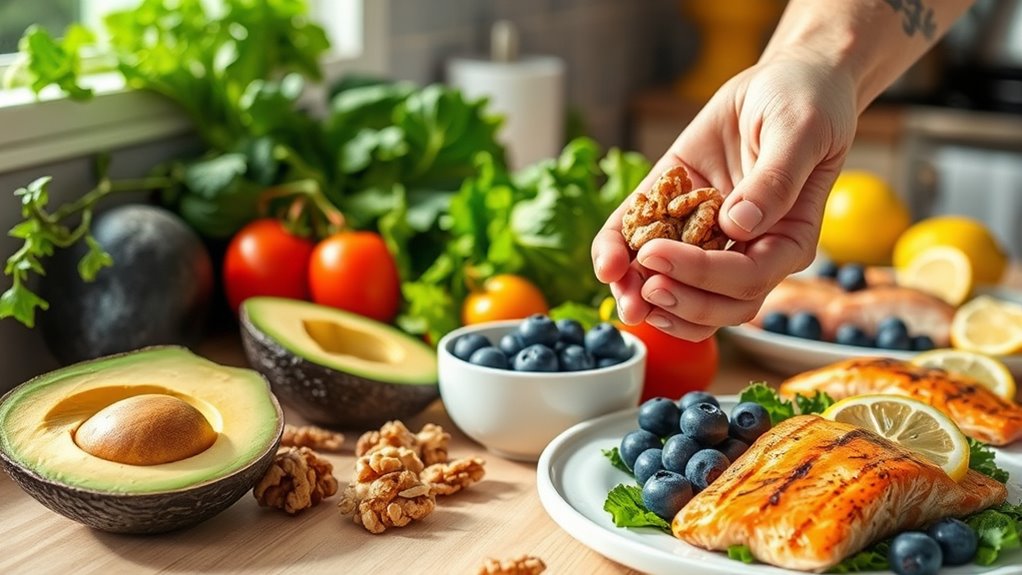To follow an anti-inflammatory diet, focus on eating colorful vegetables, berries, fatty fish, nuts, seeds, and whole grains, prepared with herbs like turmeric and ginger. Engage in gentle exercise, manage stress, and prioritize good sleep to lower inflammation. Avoid smoking and excess alcohol to support overall health. Incorporating these habits and foods can help reduce age-related risks. Keep exploring to discover simple recipes and lifestyle tips that make this lifestyle enjoyable and sustainable.
Key Takeaways
- Prioritize colorful vegetables, berries, and fatty fish to provide antioxidants and omega-3s that combat inflammation.
- Incorporate herbs like turmeric and ginger into meals for natural anti-inflammatory benefits.
- Choose whole grains and nuts over refined grains, using healthy cooking methods like steaming and baking.
- Manage stress, ensure quality sleep, and engage in gentle exercise to reduce inflammation levels.
- Avoid smoking and limit alcohol to support a balanced inflammatory response and overall health.
Understanding Inflammation and Its Impact on Aging

Have you ever wondered how inflammation affects your body as you age? Chronic inflammation plays a significant role in the development of age-related diseases, such as arthritis, heart disease, and diabetes. Over time, persistent inflammation can damage tissues, weaken your immune system, and accelerate aging processes. Unlike the acute inflammation that helps heal injuries, chronic inflammation lingers silently, often without obvious symptoms. As you get older, your body’s ability to regulate inflammation decreases, making you more vulnerable. Understanding this connection is essential because it highlights how ongoing inflammation can contribute to declining health as you age. By managing inflammation, you can potentially reduce your risk of developing many common age-related diseases and improve your overall quality of life.
Key Food Groups for an Anti-Inflammatory Lifestyle

Choosing the right foods can make a significant difference in managing inflammation as you age. Focusing on key food groups helps you harness superfoods benefits and supports overall health. Incorporate colorful vegetables like spinach and kale, rich in antioxidants that combat inflammation. Berries, such as blueberries and strawberries, are packed with vitamins and phytochemicals that reduce swelling. Fatty fish like salmon and mackerel provide omega-3s, which are essential for anti-inflammatory effects. Nuts and seeds, including walnuts and chia, offer healthy fats and protein. Whole grains like oats and brown rice sustain energy and lower inflammation. When preparing these foods, opt for steaming, baking, or raw options to preserve nutrients and maximize superfoods benefits, making your anti-inflammatory diet both flavorful and effective. Engaging in mindfulness practices can also help reduce stress-related inflammation and promote overall well-being.
Tips for Incorporating Anti-Inflammatory Foods Into Daily Meals

Incorporating anti-inflammatory foods into your daily meals becomes easier when you plan ahead and make simple substitutions. Start by adding herbs like turmeric or ginger into your recipes—these herbal supplements boost anti-inflammatory benefits. Use smart cooking techniques such as steaming, sautéing, or roasting to preserve nutrients and reduce unhealthy fats. Incorporate leafy greens, berries, and nuts into your breakfast or snacks for added benefits. When preparing meals, opt for whole grains instead of refined ones, and season dishes with anti-inflammatory herbs instead of salt. Meal prepping can help you stay consistent, and experimenting with new recipes keeps things interesting. Additionally, exploring diverse anime movies can provide a refreshing mental break, making it easier to stick to healthy routines. By making these small adjustments, you seamlessly integrate anti-inflammatory foods into your routine, supporting your health every day.
Lifestyle Habits That Support Reducing Inflammation

Adopting healthy lifestyle habits is essential for reducing inflammation and supporting overall well-being. Engaging in mindful exercise helps you stay active without overdoing it, promoting flexibility and circulation. Managing stress effectively lowers inflammation levels caused by cortisol spikes. Incorporate activities like meditation, deep breathing, or gentle yoga into your daily routine. Prioritize quality sleep, which repairs your body and reduces inflammation. Maintain social connections to boost your mood and mental health. Additionally, avoid smoking and limit alcohol intake to prevent unnecessary inflammation. These habits create a balanced lifestyle that supports your anti-inflammatory goals, helping you feel healthier and more energized every day. Incorporating Fokos into your routine can further enhance your health by supporting your body’s natural anti-inflammatory processes.
Simple Recipes and Meal Ideas for Seniors

Simple, nutrient-rich recipes can make following an anti-inflammatory diet straightforward and enjoyable for seniors. Incorporate herbal teas like ginger or chamomile to soothe your digestive system and add flavor without calories. Use spice blends such as turmeric, cinnamon, and cumin to boost the anti-inflammatory benefits of your meals. For breakfast, try oatmeal topped with fresh berries and a sprinkle of cinnamon, or enjoy a warm mug of herbal tea. Lunch could be a colorful salad with leafy greens, avocado, and a turmeric-laced dressing. For dinner, prepare grilled salmon with roasted vegetables seasoned with cumin and ginger. These simple ideas make it easy to include anti-inflammatory ingredients into your daily routine while satisfying your taste buds. Additionally, selecting the right projector technology can enhance your viewing experience and make your home cinema setup more enjoyable.
Frequently Asked Questions
Are There Specific Supplements Recommended for Seniors on an Anti-Inflammatory Diet?
You might wonder if specific supplements can support your anti-inflammatory diet. For joint health, consider supplements like glucosamine or chondroitin, which can help reduce discomfort. Omega-3 fatty acids, found in fish oil, are also beneficial for lowering inflammation. Before adding any supplements, it’s best to consult your healthcare provider to confirm they fit your individual health needs and won’t interfere with medications.
How Does Hydration Influence Inflammation in Older Adults?
Imagine giving your body a gentle hug—staying well-hydrated is just that for your inflammation levels. Proper fluid intake markedly influences hydration effects on your tissues, helping reduce swelling and soreness. When you drink enough water, you support your body’s natural anti-inflammatory processes. So, don’t overlook the power of consistent fluid intake; it’s a simple yet effective way to keep inflammation in check and promote overall health as you age.
Can Anti-Inflammatory Diets Help Manage Specific Age-Related Diseases?
You might find that anti-inflammatory diets can considerably help manage age-related diseases by supporting your immune system and aiding in chronic disease prevention. By choosing foods rich in antioxidants, healthy fats, and fiber, you strengthen your body’s defenses and reduce inflammation. This approach not only helps control symptoms but also promotes overall health, making it easier for you to stay active and independent as you age.
Are There Any Foods to Avoid Entirely on an Anti-Inflammatory Plan?
Think of your body as a finely tuned orchestra; certain foods can cause discord. You should avoid processed foods and refined sugars entirely, as they act like disruptive noise, fueling inflammation. These ingredients are like storm clouds on a clear day, blocking harmony and health. By steering clear of these culprits, you help your body stay in tune, allowing your natural vigor to shine through and keep age-related issues at bay.
How Can Seniors Maintain Variety and Enjoyment in Their Anti-Inflammatory Meals?
You can keep your anti-inflammatory meals exciting by using flavorful substitutions, like swapping herbs for salt or adding spices to boost taste. Embrace creative meal planning by trying new vegetables, grains, or lean proteins each week. This approach prevents boredom and makes healthy eating enjoyable. Remember, experimenting with different textures and colors not only enhances flavor but also keeps your diet diverse and satisfying, supporting your overall well-being.
Conclusion
By embracing an anti-inflammatory diet, you’ll turn your daily meals into powerful warriors fighting off aging and pain. Imagine your plate transforming into a vibrant battlefield, where colorful fruits, hearty greens, and spicy herbs vanquish inflammation like tiny superheroes. With every healthy bite, you’re building an unstoppable fortress of vitality that keeps you energized and pain-free. So, start today—because your future self will thank you for giving inflammation the ultimate knockout!








